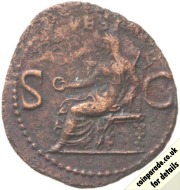
 The 37AD-38AD As - Gaius (Caligula)
The 37AD-38AD As - Gaius (Caligula)Copper As of Emperor Gaius (better known as Caligula) minted between 37AD and 38AD at the Rome Mint. This was a normal reverse for an As during Caligula. Diameter 30mm and weighs 9.8g.
The Obverse shows the bare head of Caligula facing left. Legend is "C CAESAR AVG GERMANICVS PON M TR POT".
The edge is plain.
 The Reverse is Vesta, the goddess of the hearth, home, and family, facing left, veiled with a patera (a small dish) in her right hand and angled long sceptre in her right. Legend above is "VESTA" and "S C" across. SC means senatus consultum, or 'by decree of the Senate' so the coin was an official issue.
The Reverse is Vesta, the goddess of the hearth, home, and family, facing left, veiled with a patera (a small dish) in her right hand and angled long sceptre in her right. Legend above is "VESTA" and "S C" across. SC means senatus consultum, or 'by decree of the Senate' so the coin was an official issue.Image credit: Museums Victoria
Mintage: Not known
Minted at Roman Mint
More information (monarch, year, mint, country, category) can be found below coin listings.
Below are some coins currently being offered on eBay. As an eBay Partner, We may be compensated if you make a purchase.
List items on:
List items on:
Gaius (Caligula) (Emperor 37AD-41AD)
The Emperor Gaius Julius Caesar Germanicus is better known by his nickname Caligula. Caligula was the third Roman Emperor.Born in Italy on 31 August 12AD to the popular General Germanicus and Augustus's granddaughter Agrippina the Elder, he became Emperor on 18 March 37AD. Caligula was not a nice person, killing people just for the fun of it and living a life of debauchery. He was eventually assassinated on 24 January 41AD.
Full name: GAIVS IVLIVS CAESAR AVGVSTVS GERMANICVS. Julio-Claudian dynasty.
Category: Roman
The Roman Empire was one of the largest Empires in history, covering most of Europe, Britain, parts of Asia, the Middle East and North Africa. It was in existence from 27BC to 476AD, more than 500 years. And all these places used Roman coins throughout the era.Originally coins were minted only in Rome, but by the third Century there were mints in other countries too. These mints sometimes produced more than 2 million coins per month to meet demand. Coins typically depicted the Emperor on one side and some other image or letters on the other. During the Empire, more than 10,000 different types of coins were created using copper, silver and gold.
Roman coins are usually classified as:
- Roman Republican Coins (about 300BC - 27BC)
- Roman Imperial Coins (27BC - 96AD)
- Roman Imperial Coins (96AD - 235AD)
- Roman Imperial Coins (235AD - 476AD)
- Roman Provincial Coins
The Denarius was the standard Roman silver coin and there were a range of others. As a guide, in the early republic (after 211BC) there was the Sestertius (=4 denarii), Dupondius (=5), As (=10, a tenner), Semis (=20), Quincunx (=24), Triens (=30), Quadrans (=40), Uncia (=120) and Solidus (=1000, it was gold). Values fluctuated later due to debasement and inflation.
The exchange values were as follows:
1 gold aureus = 25 silver denarii
1 silver denarius = 16 copper asses
1 brass sestertius = 4 copper asses
1 brass dupondius = 2 copper assses
1 copper as = 2 copper semisses (or 4 copper quadrantes)
The standard gold coin was the Aureus and was equal to 25 denarii or 100 sestertii. It's not far off the weight of a modern gold sovereign. The Aureus was introduced by Julius Caesar around 49BC and was the principal gold coin until about the 4th century when it was replaced by the gold Solidus.
The great part of this is that you can put together a really nice Roman coin collection with very little money, as many coins (although not all) are common and inexpensive. The coins are the best part of 2000 years old and are exciting to collect.
For more information see our articles:
Which Mint: Roman Mint
The origins of the Rome mint are from the manufacture of a silver coin near to the Temple of Juno Moneta back in 269BC. Juno was the personification of money.Due to the size of the Roman Empire, Rome could not produce all the coins needed and Roman mints were set up in 27 locations, and there were more than 600 provincial mints scattered about the Empire. During overseas campaigns, Generals such as Caesar and Marc Anthony would mint their own coins to pay their armies.
Mint marks were used on the coins to differentiate the mint of manufacture.
Country of Origin: Roman Empire
The Roman Empire ran from 27BC to 476AD and was the post-Republican period of ancient Rome. It covered a large territory of Europe, Northern Africa, and Western Asia. It was ruled by an Emperor.







